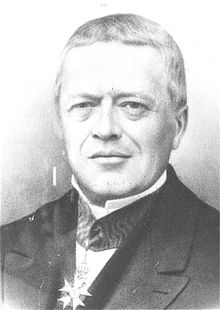Augustin Cournot
| Antoine Augustin Cournot | |
|---|---|
 |
|
| Born |
28 August 1801 Gray, Haute-Saône, France |
| Died | 31 March 1877 (aged 75) Paris, France |
| Nationality | French |
| Alma mater | Sorbonne University |
| Known for |
Cournot competition Oligopoly |
| Scientific career | |
| Fields | Economics Mathematics |
| Institutions | University of Grenoble |
| Influences | Nicolas-François Canard |
| Influenced |
Gabriel Tarde Léon Walras |
Antoine Augustin Cournot (28 August 1801 – 31 March 1877) was a French philosopher and mathematician who also contributed to the development of economics theory.
Antoine Augustin Cournot was born at Gray, Haute-Saône. In 1821 he entered one of the most prestigious Grande École, the École Normale Supérieure, and, according to Sandmo:
in 1823 he took a license degree in mathematics at Sorbonne University. He then became the private secretary of a field marshal who required assistance in writing his memoirs. This position does not leave Cournot with considerable time for his own pursuits, for in the course of his ten years in the field marshal's employment he took two doctoral degrees, one in mechanics and one in astronomy. In addition, he published a number of articles and even acquired a degree in law.
Subsequently, Cournot held positions as professor of mathematics, chief examiner for undergraduate students, and rector of Dijon Academy.
Cournot was mainly a mathematician, but did have some influence over economics. His theories on monopolies and duopolies are still famous. In 1838 the book Researches on the Mathematical Principles of the Theory of Wealth was published, in which he used the application of the formulas and symbols of mathematics in economic analysis. This book was highly criticized and not very successful during Cournot's lifetime, and he did try to rewrite it twice, but it still has influence in economics today. Today many economists believe this book to be the point of departure for modern economic analysis. Cournot introduced the ideas of functions and probability into economic analysis. He derived the first formula for the rule of supply and demand as a function of price and in fact was the first to draw supply and demand curves on a graph, anticipating the work of Alfred Marshall by roughly thirty years. The Cournot duopoly model developed in his book also introduced the concept of a (pure strategy) Nash equilibrium, the Reaction function and best-response dynamics.
...
Wikipedia
